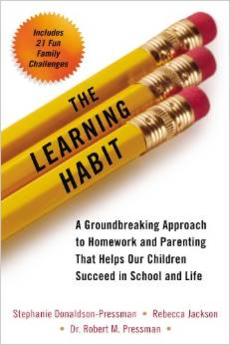
Friends
The Toughest Decisions in Life are Gray
For kids, the decision between bad and bad is infinitely more complex.
Posted December 9, 2014

Important decisions aren’t black and white. In fact, they are surprisingly gray. Hard choices don’t have a fairytale ending – the real ending is one we often replay over and over in our minds. I frequently find that the most infuriating choices are between bad and bad – two somewhat equally unappealing choices. When I make these painful decisions, I actually have a system I use. I make a list of my choices, and write down the possible outcomes; the bad and the bad. I ultimately choose the one I can live with, and accept the consequences that surround it.
For kids, the decision between bad and bad is infinitely more complex. Children aren’t traditionally taught how to make “gray” decisions. When my co-author Stephanie Donaldson-Pressman and I were researching learning habits in children, we couldn’t find case studies about children who had made challenging ethical decisions. There weren’t any.
Stephanie and I spent years researching and gathering stories for a single chapter in our book, The Learning Habit, on options and consequences. Our hope is that both educators and parents will use excerpts from The Learning Habit as a way to facilitate conversations about life’s toughest choices – the ones that are gray.
The following is an excerpt from The Learning Habit by Stephanie Donaldson-Pressman, Rebecca Jackson and Dr. Robert Pressman by arrangement with Perigee, a member of Penguin Group (USA) LLC, a Penguin Random House Company, Copyright © 2014 by Good Parent, Inc.
Case Study: Noah’s Decision
Noah (age 12) was quite small for his age. Academic records detail that he performed in the “superior” range for a seventh grader. According to both parents, he had been self-conscious about his height since third grade. His dad and older brother, both tall, kept reassuring him that he would have a growth spurt in a couple of years, but Noah was worried that he wouldn’t. In family interviews I did note that his mother and sister are both extremely small.
Noah was tired of being called “Short Stuff” by the guys in his school, even though he knew they were just fooling around. His parent’s friends would frequently guess that he was in the fourth grade – the same grade as his eight year old sister. Every time he had to get something from the top shelf of his gym locker, someone said, “Hey, you need a ladder to reach that?” He could usually think of a funny response, and everybody laughed. Those guys were his friends - they knew he’d come back with a fierce remark.
One child, Howard, wasn’t a friend and wasn’t innocently fooling around. He seemed to single Noah out for ridicule. If he passed Noah in the hall, he’d always bump into him, elbow him, knock his books, or trip him. According to Noah, Howard seemed to “have it out for him.” Noah didn’t know why, but he knew Howard had disliked him for a few years. Therefore, he made a careful not to get caught alone with him at school.
On Wednesday, December 7, 2011 Noah checked his backpack and realized he forgot his ELA textbook.
He needed it for a homework assignment and had to run back to his locker to grab it at the end of school. Howard was there. He started pushing Noah and taunting him, calling him names, and daring Noah to punch him. Noah remembers feeling two things; terrified and slow (he later said it felt like he couldn’t immediately react – this is common during trauma)
Normally he’d just toss out a wise remark to level the playing field and everyone laughed. Clearly, that wasn’t going to work this time. Howard was a huge kid, looking for a fight; there was no one in the corridor to diffuse the situation.
Noah felt like crying; he was scared out of his mind. Howard pushed him into the locker and said, “Go ahead smart-mouth, you’re not so funny now. Hit me, you little piss-ant!” At that precise moment, he heard girls’ voices—and the command, “No running in the halls!” from the scary vice principal.
Noah had three choices:
- Choice 1: Yell for help
- Choice 2: Do nothing and take the beating
- Choice 3: Punch Howard
THE REAL ENDING
Noah was really scared; he was afraid of finally being beaten up by Howard. He was also tired of being scared, and the thought of anyone seeing him like that—cowering, on the verge of tears, trapped in his locker—was too awful to contemplate.
Noah knew that no matter what he did it would have a negative outcome. His choices were between bad, bad, and bad. His school had a zero-tolerance policy for fighting. In fact, another kid in his class was being bullied, and he’d gotten expelled just like the bully did when he fought back.
Noah made his decision; he pulled his elbow back as far as it would go and smashed Howard with his closed fist, as hard as he could. He connected directly with the other boy’s nose, which made a sickening cracking noise. Simultaneously, three things happened:
- Howard stumbled back, with his hands over his face and blood all over. “You broke my nose!” he cried.
- Noah burst into tears.
- The vice principal and the sixth grade girls’ volleyball team came running around the corner.
Howard was sent to the nurse, who called his mother. Noah was escorted to the office by Vice Principal Broder, who called his mother. She asked him what had happened, and he told her.
After Noah’s mother arrived at school, Ms. Broder told her,
“This school has a zero-tolerance policy; fighting is grounds for automatic suspension and, without proven extenuation, expulsion. Your son, as is required by law, will now be suspended until I can contact the superintendent and get a hearing.”
Ms. Broder then addressed Noah, “You understand that I have to suspend you for fighting, don’t you?”
Noah said, “Yes.”
“You’ve always been an excellent student, but this school has policies that must be followed.”
Noah felt like crying again. He just nodded.
It felt as if the walls were closing in on him. He never wanted to hit anybody ever again; it was a sickening feeling. He thought he might throw up.
His parents told him that they did not approve of violence, but that they could understand his predicament.
Noah was expelled and transferred to another school. The school board’s decision was based on the facts: They had no record of Noah ever complaining about Howard’s bullying, but they had an X-ray of Howard’s broken nose.
Student Discussion Points:
- Many parents and educators who have read The Learning Habit found the decision Noah made unacceptable. However, he made it knowing that the “worst case scenario,” for him, was not being expelled—it was being afraid every single day or actually being beaten up. Do you agree or disagree with Noah's decision?
- Do you practice making decisions by thinking about the "long term" or "short term" impact they have on your life?
- Give an example of a "Gray" decision you've made (bad vs bad). In retrospect, did you have all the information you needed at the time to make the decision?
- Noah believed that he had the situation with Howard "under control" and that it erupted suddenly one day after school. Do you agree with his perception of the situation?
Click HERE to purchase The Learning Habit.





